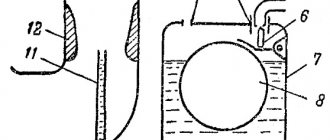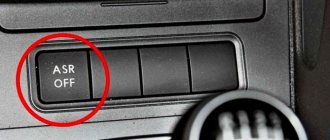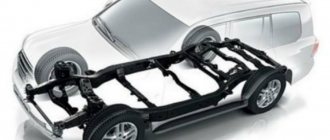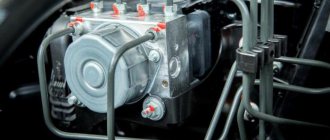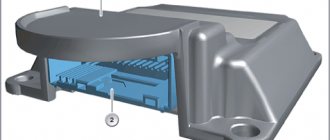06.11.2019
| (Votes: 1, Rating: 5) |
Issues discussed in the material:
- How do airbags work and how do they work?
- What are the different types of airbags for?
- What is the service life of car airbags?
- How to check airbags when buying a car
- For which airbag malfunctions is it not recommended to use the car?
A mandatory attribute of a modern car is the SRS system. If it works properly, then the people in the car at the time of the accident will remain alive. Otherwise, the consequences of an accident may be irreparable.
The long history of using the airbag has shown that this invention saved many people from imminent death. This complex system comes into action a few fractions of a second after a collision occurs. This is the only way to 100% protect everyone in the vehicle. Today we will look at what airbags are in a car and how they function.
A little history
Photo: caradvice.com.au
The birthplace of airbags, as you might guess, is the USA. Back in the early 50s, engineers John Hendrick and Walter Linderer patented an inflatable bag that was triggered in the event of an accident. True, for quite a long time designers puzzled over a sensor that could send a signal in the event of a collision. The solution was found in 1967, when inventor Allen Breed proposed a ball sensor that responded to a very sudden change in speed that could only occur during an impact. Breed sold the technology to Chrysler, but the concern's worst competitors became pioneers in the mass production of cars with pillows.
However, this will happen only four years later. And while automakers were busy implementing the technology, congressmen entered the arena. The plans were ambitious: wanting to show voters that they cared about their lives, deputies passed a law obliging all production cars to be equipped with airbags by 1973. The idea was openly populist, but under pressure from the authorities, car companies were forced to speed up development.
One after another in 1971, the Ford Taunus P7 and Oldsmoblie Toronado were released, equipped as an option with inflatable bags for the driver and passenger. True, back then the airbags were positioned as an alternative to seat belts, and it soon became clear that the idea was a failure. Americans were afraid of pillows and did not want to overpay for them. Several deaths added fuel to the fire - drivers died of heart attacks, shocked by the loud pop with which the airbags inflated.
Looking ahead, it is worth mentioning that airbags on American cars only became mandatory in 1998. And in 1981, the first European car with inflatable bags appeared.
It was the Mercedes-Benz S-class in the then-new W126 body, which allowed it to be named the safest car in the world for two years in a row (in 1988 and 1989) according to the American Institute for the Study of Highway Mortality.
In the 90s, when tests proved the effectiveness of airbags, they began to be used everywhere. In Russia they are still not mandatory, perhaps also because it is simply not cost-effective to install them on a number of archaic models. The VAZ “classics” and “Samara” are history.
The last of the Mohicans remains the Lada 4x4, better known as the Niva - you cannot install airbags on it at any cost. But Granta, Kalina, Priora and Largus have them in their “base”, which gives us hope for a bright future.
How are modern pillows arranged?
There is nothing particularly clever in the design of the pillow itself - it is a bag made of thin fabric (usually nylon). Often these bags have several chambers. For example, the passenger front is divided into a larger lower section for the body and a smaller one for the head. The bag is placed in a compact capsule and sprinkled with talcum powder or starch to prevent caking. It is this powder that sometimes flies in the air after the system is activated.
Photo: verkehr.fraunhofer.de
Initially, it was clear that the airbags had to be inflated very quickly - in 20-50 milliseconds. Since the 70s of the last century, the only possible means for this has been a small explosion, which results in the release of gas that fills the space inside the bag. The explosion is provided by a squib, which detonates a piece of fuel made from sodium azide (not to be confused with oxide!), potassium nitrate and silicon dioxide. The explosion produces harmless, non-toxic nitrogen. There are also hybrid filling units, in which the charge of solid fuel is just a “plug” plugging a cylinder with compressed nitrogen. The force of the explosion is lower, and the noise is also less.
In modern cars, the command to fire the airbags is given by an electronic control unit, which collects information from impact sensors. There are a lot of sensors, and the computer can distinguish in which direction the blow fell. Therefore, if the car is hit on the side, the front airbags will not work. More advanced systems also take into account the force of the impact and even the weight of the passenger, adjusting the amount of gas entering the airbag and, accordingly, its size.
Types of gas generator
The task of each generator is to fill the shell of the protective device with which it forms a module of this device with gas. Generators come in a variety of shapes, modes of operation, and gas production. Depending on these vectors, the generator can be dome-shaped or tubular. According to the methods of operation, there are generators with one- and two-stage modes of operation. There are also solid fuel and hybrid models. In addition to housings and cartridges, they include: a solid fuel version - a special mixture composed of sodium azide, silicon dioxide, potassium nitrate, a hybrid version - a high-pressure gas charge. The latest models of airbags are equipped with two squibs. The main one releases 80% of the total gas volume (in the format of a so-called soft landing), and the additional one serves to protect the main one in case of a very heavy impact.
Where are the airbags located?
Traditionally, frontal airbags are located in the steering wheel housing for the driver and in the dashboard for the passenger. Side airbags can be placed in different places: in or above the doors, in pillars or seat backs. Often there are combined solutions: for example, a curtain shoots out from a slot above the door to protect the head, and a second lower pillow shoots out from the chair to protect the chest, abdomen and pelvis.
The legs are protected from contact with the hard plastic of the dashboard by a knee pad, which is “wired” under the steering wheel. In 2009, Toyota also introduced central airbags - they are located in the seat back or in the armrest and prevent injuries that the driver and passenger can inflict on each other in a side impact.
Photo: autoblog.com
For motorcyclists and cyclists
In 2006, the first motorcycle with an airbag debuted, the big Honda Goldwing chopper. The pillow is built into its front panel and is generally similar to a car one. So far, the technology has not been widely used by competitors.
Motorcyclists, especially extreme riders, prefer… suits with pillows to “automotive” solutions. The capsule with it is located on the neck; when it falls, it opens like a collar, and instead of hard asphalt, the biker hits his head on soft fabric.
Protective curtains
In fact, these elements can also be considered head airbags, since they are designed to protect this most important part of the body from side impacts, including flying glass fragments. Cars are usually equipped with two types of curtains:
- only for the first row;
- for both rows (front and back).
They are located on the side of the cabin ceiling, respectively, above the windows themselves. When hitting the side of the car, the curtains open so as to completely cover the side windows. That is, it provides protection from splinters, impacts against racks and other hard objects.
And for pedestrians too
If you have a particularly tender love for pedestrians, then your car is the Volvo V40 Cross Country. This is the only car on the Russian market (and also the first production car in the world) that is equipped with an airbag for pedestrians. It is located under the hood and shoots, lifting it and covering almost the entire windshield. Unfortunately, this device does not protect you from broken legs (the edge of the hood and the bumper remain rigid), but it does protect you from a traumatic brain injury.
But how does the V40 understand that a collision occurred with a pedestrian, and not, say, with a pole? A thermal imager is responsible for this, which measures the temperature of the object the car is approaching from a distance. In addition to the unique airbag, Volvo also has a City Safety system with forced emergency braking. So, ideally, a pedestrian should not need a pillow at all.
Some statistics
Research activity regarding the effectiveness of airbags peaked in the early 2000s. Pillows have been widely adopted since the early 90s, and a decade later, researchers have a basis to study.
In 2001, the US Highway Safety Administration (NHTSA) concluded that airbags saved more than 8,000 lives in the first decade. In 2009, NHTSA calculated that when seat belts are worn, frontal airbags reduce the risk of death by 11%.
Photo: emercedesbenz.com
In 2003, doctors Eliza Braver and Sergei Kirichenko studied accident data in the United States in 1999-2001, and came to the quite expected conclusion that the presence of side airbags in a car significantly reduces the risk of death in a side collision. Statistics were collected exclusively on then-modern cars of the 1997-2002 model years.
And now the specifics: over two years, 1,800 people died in side collisions in cars without side airbags at all, 105 people died in cars equipped only with torso airbags, and only 35 people died in vehicles with inflatable curtains to protect the head. It turns out that the presence of side airbags reduces the risk of death in an accident by one or two orders of magnitude. A good reason to think about the configuration of your car.
Photo: emercedesbenz.com
It is worth noting that any statistical analysis is something conditional. It is always difficult to identify the exact cause of a person’s death in an accident, and even more so to understand why the person who survived the accident did not die. In this case, full-scale tests of cars with airbags, that is, crash tests, are very useful.
Device
Such an important element of the security system does not have such a complex structure. It can all be roughly divided into three main components, which together ensure the safety of a person in the event of an accident. The main components are presented:
- bag;
- shock sensors;
- gas generator (inflating system).
The entire complex is compactly equipped and located in such a way that it cannot be seen from the salon. Each of these components is very important for the smooth operation of the entire system.
But it is the sensor that is particularly sensitive, because it is its decision that determines when the pillow will be released. We can assume that the fate of everyone in the car depends on it.
Pillow tests
Airbags need to be tested in practice, so the most objective criteria for evaluating them are the results of crash tests. As you know, there are several national standards in the world. In particular, the European Union uses the Euro NCAP protocol, the USA uses IIHS and NHTSA, Japan uses JNCAP, and China uses C-NCAP. The latter, as you might guess, is the most liberal of all.
Sometimes crash tests helped identify specific deficiencies in airbags. So, in 1998, when a BMW 5 Series in the back of an E39 was crashed using the Euro NCAP method, it became clear that the airbags responded too slowly. The shock sensors and airbag control unit were modernized, and only after that the “five” went on sale.
Video: autoblog.com
In 2012, the American organization NHTSA, already known to us, conducted separate bench tests... of counterfeit airbags. The video they published following the tests is impressive. Non-original cheap pillows, which are often offered at car repair shops as a replacement for expensive original ones, do not open completely or even explode.
Another interesting test involves child seats. As you know, if a child is sitting in the front seat in a chair, the passenger airbag must be turned off, otherwise it will hit the baby painfully in the face. Which, in fact, was proven by researchers during a crash test.
Video: youtube.com/user/Avtodeti
The Russian experience is also interesting. Thus, the Autoreview magazine tested the Lada Kalina using its own methodology, comparing the results for identical cars with and without airbags. The first Kalina scored 8.4 points out of 16 possible, and the second - 5.6 points. Thus, the main role in ensuring the safety of a person inside a car is played by the design of the car: in particular, how well the impact force is absorbed and how it is distributed throughout the body. A pillow is an auxiliary thing.
Video: youtube.com/user/oxion812
What if it doesn't work?
At the beginning of 2014, the American automobile publication Automotive Information conducted its own study of the federal accident database and concluded: every year in the United States, about 3,400 people die in frontal collisions due to the fact that the airbag does not deploy. As we have already said, there can be no clear conclusions here, but the fact remains: the airbags may not work.
Common reasons include errors in the control unit, damage to the wiring, old age of the pillows themselves (the bag itself can simply become caked due to age), and also... lack of power! In particular, the researchers were able to prove 12 cases where the airbag did not deploy due to a problem in the ignition system of the Chevrolet Cobalt and its companion Saturn Ion. Both of these models are subject to a recall campaign. Russians don’t have to worry about this: our Chevrolet Cobalt has nothing in common with the American one except the name.
Under what conditions does the protection system operate?
It is also worth highlighting the following point - airbags do not work just like that. So when you're driving, they'll never fly in your face for no reason. Moreover, even in the event of an accident at a speed of up to 20 km, the sensor will not give a signal to release the airbags, since the inertial force is still too insignificant.
Separately, it is worth noting cases when the car owner decides to repair the interior trim in the areas where the airbags are located. To prevent accidental opening and subsequent injury, you should remove the terminals from the battery, and only then undertake repairs.
Do I need to wear a seat belt?
As we already know from history, airbags could not become a replacement for seat belts. And yet, some irresponsible drivers drive without seat belts in the hope that in the event of an accident, the airbag will save their life. But in reality, in the absence of belts, the pillow turns from a helper into a deadly enemy.
The fact is that in the event of a collision, the airbag flies out towards the driver or passenger at a speed of 200 to 300 kilometers per hour. If a person is not wearing a seat belt, he or she runs the risk of coming face to face with an inflated airbag and receiving a blow more severe than from a collision with the steering wheel or dashboard.
The person must be at least 25 centimeters away from the place where the pillow flies out. Therefore, it is vital to always buckle up, and also remember to turn off the passenger airbag if a child seat is installed in the front seat.
General tips for replacing SRS
If you are weak in electronics, then I will immediately say that you should not start this business yourself, you will not be able to get by with just unscrewing the bolts and replacing it with a new part; you will have to rearrange the sensors and flash the control unit.
The on-board computer has its own nuances, and when the airbag is deployed, the on-board computer records an error in its memory. Therefore, it will also have to be replaced entirely, if not flashed.
Let's consider the replacement process itself, when the impact falls on the front or rear bumper; these are the situations that arise most often. To do this, we will need to replace two airbags, the driver's on the steering wheel and the passenger's.
Shot pillows
An airbag is a purely disposable thing. If it fires, you will have to replace the entire module along with the bag and filling unit. The cost of such a module is usually quite high. For example, on a Ford Focus 2, the driver’s airbag module costs about 21,000 rubles, and on an Opel Astra H – 44,000.
Photo: by alegri / 4freephotos.com
Therefore, it is not at all surprising that when a car is sold after an accident, they install external plugs instead of airbags and reflash the control unit so that computer diagnostics do not show errors. It is impossible to reliably determine whether the pillow “shot” or not. So when buying a used car, pay attention to other signs of accident involvement, such as repainted body parts and rust.
Location in the car
To determine where and what airbags are in the car, it is not at all necessary to open the technical documentation. The regulations require manufacturers to indicate their locations with an engraving or tag.
So, you can find out if certain airbags are in your car as follows:
- The front ones are indicated by an engraving on the central part of the steering wheel and on the shield above the glove compartment;
- Knees are designated similarly. The engraving can be found under the steering column and under the glove compartment section;
- Side pillows and curtains give themselves away as a tag. True, you will have to look for it carefully, since manufacturers like to hide them for the sake of aesthetics.
By the way, when buying a used car, you should not rely only on the designations. The pillows are disposable, and the car may have already been in an accident. Therefore, it is better to look at the interior trim next to the airbag designations. If there are cracks, holes or signs of repairs to the trim, most likely the cushions are no longer there.
What's next?
So, over the past 30 years, airbags have gone from being a fancy accessory for expensive cars like the Mercedes-Benz S-class to becoming an absolutely mandatory attribute of any modern car, including in Russia (with rare exceptions). A modern driver will think ten times before getting into a car without airbags.
One can only guess how pillows will develop in the future. Most likely, they will simply become even more widespread: production technology will gradually become cheaper, and the day is not far off when we will see budget cars with a full set of airbags, including knee and curtain airbags. Perhaps designers will pay more attention to the safety of rear passengers, and, of course, Volvo's pedestrian protection technology should be widely used.
| The ten safest cars based on EuroNCAP crash tests in the review by Kolesa.Ru. |

